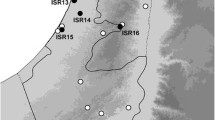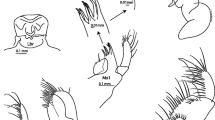Abstract
Using morphological and molecular techniques we examined the corophiid amphipods in the Waimapu Estuary, Tauranga Harbour in the North Island of New Zealand. Based on morphology we identified two New Zealand endemic species, Paracorophium lucasi and P. excavatum, as well as P. brisbanensis, previously recorded only from the eastern coast of Australia and Corophium sp. which has not been previously recorded from New Zealand. Allozyme analyses confirmed the morphological diagnoses of three distinct species within Paracorophium and of the single Corophium species. The presence of reproductive females and juvenile P. brisbanensis suggests a viable, breeding population in Tauranga Harbour. We conclude that the species is likely to have been introduced to New Zealand waters via shipping activities (e.g., ballast water). The possibility that P. brisbanensis may now spread to other New Zealand ports as well as the consequences of this introduction for other New Zealand taxa need to be urgently examined.
Similar content being viewed by others
References
Carlton, J. T. & J. B. Geller, 1993. Ecological Roulette: the global transport of nonindigenous marine organisms. Science 261: 78-82.
Chapman, M. A., 2002. Australasian species of Paracorophium (Crustacea, Amphipoda): the separate identities of P. excavatum (Thomson, 1884) and P. brisbanensis sp.nov. J. r. Soc. New Zealand 32(2): in press.
Chapman, M. A., I. D. Hogg, K. E. Schnabel & M. I. Stevens, 2002. Synonymy of the New Zealand corophiid amphipod genus Chaetocorophium Karaman, 1979, with Paracorophium Stebbing, 1899: morphological and genetic evidence. J. r. Soc. N.Z. 32(2): in press.
Commito, J. A., S. F. Thrush, R. D. Pridmore, J. E. Hewitt & V. J. Cummings, 1995. Dispersal dynamics in a wind-driven benthic system. Limnol. Oceanogr. 40: 1513-1518.
Costello, M. J., 1992. Biogeography of alien amphipods occurring in Ireland, and interactions with native species. Crustaceana 65: 287-299.
Crawford, G. I., 1937. A review of the amphipod genus Corophium, with notes on the British species. J. mar. biol. Ass. U.K. 21: 589-630.
Den Hartog, C., F. W. B. Van Den Brink & G. Van Der Veld, 1992. Why was the invasion of the river Rhine by Corophium curvispinum and Corbicula species so successful? J. nat. Hist. 26: 1121-1129.
Dick, J. T. A., 1996. Post-invasion amphipod communities of Lough Neagh, Northern Ireland: influences of habitat selection and mutual predation. J. anim. Ecol. 65: 756-767.
Emerson, C. W. & J. Grant, 1991. The control of soft-shell clam (Mya arenaria) recruitment on intertidal sandflats by bedload sediment transport. Limnol. Oceanogr. 36: 1288-1300.
Hebert, P. D. N. & M. J. Beaton, 1993. Methodologies for allozyme analysis using cellulose acetate electrophoresis: a practical handbook. Helena Laboratories, Beaumont, Texas.
Hebert, P. D. N., B. W. Muncaster & G. L. Mackie, 1989. Ecological and genetic studies on Dreissna polymorpha (Pallas): a new mollusc in the Great Lakes. Can. J. Fish. aquat. Sci. 46: 1587-1591.
Hurley, D. E., 1954. Studies on the New Zealand amphipodan fauna no. 7. The family Corophiidae, including a new species of Paracorophium. Trans. r. Soc. New Zealand 82: 431-460.
Mills, E. L., J. H. Leach, J. T. Carlton & C. L. Secor, 1993a. Exotic species in the Great Lakes: a history of biotic crises and anthropogenic introductions. J. Great Lakes Res. 19: 1-54.
Mills, E. L., R. M. Dermott, E. F. Roseman, D. Dustin, E. Mellina, D. B. Conn & A. P. Spidle, 1993b. Colonization, ecology, and population structure of the ‘Quagga’ mussell (Bivalvia: Dressenidae) in the lower Great Lakes. Can. J. Fish. aquat. Sci. 50: 2305-2314.
Nei, M., 1978. Estimation of average heterozygosity and genetic distance from a small number of individuals. Genetics 89: 583-590.
Nei, M., 1987. Molecular Evolutionary Genetics. Columbia University Press, New York.
Pinkster, S., N. Scheepmaker, D. Platvoet & N. Brookdbakker, 1992. Drastic changes in the amphipod fauna (Crustacea) of Dutch inland waters during the last 25 years. Bijdragen tot de Dierkunde 61: 193-204.
Richardson, B. J., P. R. Baverstock & M. Adams, 1986. Allozyme Electrophoresis: a Handbook of Animal Systematics and Population Studies. New York, Academic Press.
Schnabel, K. E., I. D. Hogg & M. A. Chapman, 2000. Population genetic structure of two New Zealand corophiid amphipods and the presence of morphologically cryptic species: implications for conservation of diversity. New Zealand J. mar. Freshwat. Res. 34: 637-644.
Smith, M. H., J. C. Britton, P. Burke, R. K. Chesser, M. W. Smith & J. Hagen, 1979. Genetic variation in Corbicula, an invading species. In Britton, J. C. (ed.), Proceedings of the 1st International Corbicula Symposium. Texas Christian University Research Foundation: 243-248.
Spidle, A. P., J. E. Marsden & B. May, 1994. Identification of the Great Lakes Quagga mussel as Dreissena bugensis from the Dnieper River, Ukraine, on the basis of allozyme variation. Can. J. Fish. aquat. Sci. 51: 1485-1489.
Stebbing, T. R. R., 1899. On the true Podocerus and some new genera of Amphipods. Ann. Magazine Nat. Hist. 3: 237-241.
Stepien, C. A., A. K. Dillon & M. D. Chandler, 1998. Genetic identity, phylogeography, and systematics of ruffe Gymnocephalus in the North American Great Lakes and Eurasia. J. Great Lakes Res. 24: 361-378.
Swofford, D. L. & R. B. Selander, 1981. BIOSYS-1: a FORTRAN program for the comprehensive analysis of electrophoretic data in population genetics and systematics. J. Hered. 72: 281-283.
Thomson, G. M., 1884. Descriptions of New Zealand crustaceans. Trans. New Zealand Inst. 16: 234-240.
Witt, J. D. S., P. D. N. Hebert & W. B. Morton, 1997. Echinogammarus ischnus: another crustacean invader in the Laurentian Great Lakes basin. Can. J. Fish. aquat. Sci. 54: 264-268.
Author information
Authors and Affiliations
Rights and permissions
About this article
Cite this article
Stevens, M.I., Hogg, I.D. & Chapman, M.A. The corophiid amphipods of Tauranga Harbour, New Zealand: evidence of an Australian crustacean invader. Hydrobiologia 474, 147–154 (2002). https://doi.org/10.1023/A:1016575519015
Issue Date:
DOI: https://doi.org/10.1023/A:1016575519015




